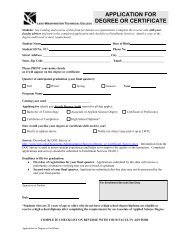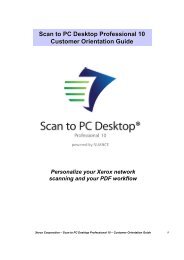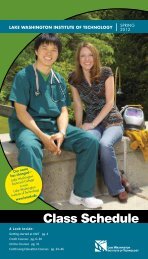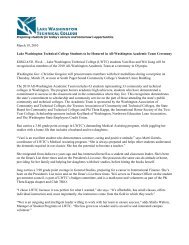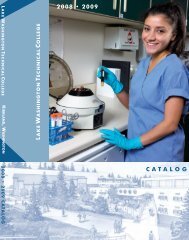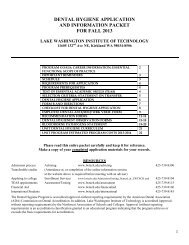2 - Lake Washington Institute of Technology
2 - Lake Washington Institute of Technology
2 - Lake Washington Institute of Technology
You also want an ePaper? Increase the reach of your titles
YUMPU automatically turns print PDFs into web optimized ePapers that Google loves.
Programs <strong>of</strong> Study 2<br />
Electronics <strong>Technology</strong><br />
www.lwtech.edu/electronics<br />
ELECTRONICS TECHNOLOGY<br />
ASSOCIATE IN APPLIED SCIENCE DEGREE<br />
120 CREDITS<br />
Admission Dates: Fall, Winter, Spring, Summer<br />
Program Mission: The Electronics <strong>Technology</strong> AAS<br />
degree prepares students to utilize the skills learned<br />
in this program to enter into either the electronics<br />
manufacturing industry as engineering technicians,<br />
electronics specialists, inspectors, managers, and testers,<br />
or into any <strong>of</strong> the high-tech industry maintaining<br />
multi-million dollar machines and devices utilized<br />
in almost all high-tech fields today.<br />
The Electronics <strong>Technology</strong> AAS degree exposes students<br />
to a basic core <strong>of</strong> skills through advanced electronics<br />
principles and applications. By focusing on the idea that<br />
a career in high-tech involves constant and continuing<br />
education, the student learns the importance <strong>of</strong><br />
life-long learning. Through this, the program prepares its<br />
graduates for entry level positions in the rapidly growing<br />
high-tech industries <strong>of</strong> the 21st century.<br />
Electronics <strong>Technology</strong> AAS degree graduates will:<br />
be prepared to obtain entry-level positions as electronics<br />
technicians, installers, assemblers and troubleshooters<br />
be prepared with the skills to perform standard<br />
workplace functions with minimal supervision<br />
demonstrate critical thinking, teamwork,<br />
communication, intercultural appreciation, and<br />
technical and information literacy skills<br />
meet Social Science, Humanities, Written<br />
Communication, and Quantitative Reasoning<br />
distribution area outcomes<br />
<strong>Lake</strong> <strong>Washington</strong> <strong>Institute</strong> <strong>of</strong> <strong>Technology</strong> does not<br />
<strong>of</strong>fer every course each quarter. It is the student’s<br />
responsibility to consult the Class Schedule and work out<br />
an individual schedule with an adviser or counselor. Any<br />
developmental coursework a student may be required to<br />
complete may increase the program length.<br />
PROGRAM REQUIREMENTS<br />
ELEC 110 Introduction to Electronics I. ....................6<br />
ELEC 111 Computer Literacy for<br />
Electronics Pr<strong>of</strong>essionals. .......................2<br />
ELEC 113 Career Planning & Leadership I. .................2<br />
ELEC 114 Electronic Testing Processes & Techniques I ......2<br />
ELEC 115 Electronics Manufacturing<br />
Testing Techniques I. ...........................5<br />
ELEC 116 Introduction to Programmable<br />
Logic Controllers. ..............................5<br />
ELEC 120 Introduction to Electronics II. ...................6<br />
ELEC 126 Electronics Manufacturing<br />
Testing Techniques II ...........................5<br />
ELEC 130 Electricity & Electronics. ........................6<br />
ELEC 137 Introduction to Semi & Analog. .................5<br />
ELEC 211 Digital Electronics. .............................6<br />
ELEC 213 Career Planning & Leadership II .................2<br />
ELEC 214 Troubleshooting Electronic Circuits. .............4<br />
ELEC 216 Mechatronics. .................................4<br />
ELEC 217 Data Acquisition & Analysis. ....................5<br />
ELEC 221 FCC/CET Preparation ...........................1<br />
ELEC 223 Communication Electronics. ....................5<br />
ELEC 224 Electronic Circuits. .............................5<br />
ELEC 225 Linear Circuits. .................................5<br />
ELEC 226 Introduction to Automation/<br />
Electromechanical. . . . . . . . . . . . . . . . . . . . . . . . . . . . . 4<br />
ELEC 237 Intro to Microprocessors Microcontrollers. .......5<br />
ELEC 239 Printed Circuit Board Layout & Design. ..........6<br />
ELEC 297 Electronic Capstone, Degree Level. ..............4<br />
ACADEMIC CORE REQUIREMENTS – 20 CREDITS<br />
Written Communication. .......................5<br />
Humanities. ...................................5<br />
Quantitative Reasoning. ........................5<br />
Social Science. .................................5<br />
TOTAL PROGRAM CREDITS .......................... 120<br />
See page 15 for a list <strong>of</strong> all applicable courses for each <strong>of</strong> the<br />
categories listed above.<br />
Programs <strong>of</strong> Study<br />
2 0 1 3 - 2 0 1 4 • L A K E W A S H I N G T O N I N S T I T U T E O F T E C H N O L O G Y • C A T A L O G 77





